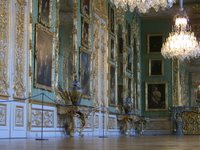The first picture is of the front of the Salzburg, Austria, building that was the birthplace of Mozart. Interestingly enough, this year marks Mozart's 250th birthday. Wolfgang was the son of Leopold who realized when Wolfgang was only 6 years old that he was a musical genius. This spurred concert tours that took Wolfgang and his sister throughout Europe in a day and age when travel was not easy. Imagine a 6 year old traveling to the palaces and concert halls of Europe to perform for royalty and others. He composed his first opera at age 12 and went on to be one of the most productive composers of all time, even though he died at the age of 35. The thing that was amazing about going to Mozart's birthplace was that there was a map at the end of the historical exhibit indicating where Mozart traveled during his concert tours. To my great surprise, over the two months I was in Europe, I traveled almost all the paths Mozart traveled with the exception of Naples, Italy, and London. It gave me great satisfaction to know that I had been to most of these great European cities that welcomed Mozart.

The Salzburg, Austria, Fortress rises above the landscape on a high hill in the middle of an incredible range of mountains surrounding the city. This Fortress was never taken by hostile forces during all the European battles for land and domination until the Fortress opened its doors willingly to Napolean. I don't know the reason for not fighting Napolean unless it was an inevitable belief that Austria would lose. The Fortress is a landmark but it also represents a period of European history when all possessions had to be protected from invading forces of nobility or dictators. The EU has now bonded together to assure that these hostilities will never again plague Europe.

Salzburg is filled with churches, most of which were designed and decorated in high Baroque style. St. Peters' church is one of the most beautiful. This picture was taken early in the morning before many people had begun their tourism treks. It was wonderful to see it with all the Christmas lights and candles. The opulence of the place was overwhelming, as many churches/cathedrals throughout Europe are.

Munich, Germany, was our last stop on our way back to Frankfurt and home. Munich was a wonderful surprise. It was snowing but people were everywhere - shopping, ice skating, and enjoying the last days of the Christmas Market. Munich will be one of the cities to which I will return to learn more. It was the home of much of the Bavarian royal family and the Residenz is proof of it. The sculpture hall that is pictured first served in the early days of the Residenz as an entry hall, lined with the sculptures that had been collected by the royal family. Later, the sculpture hall was used for banquets and other events as other areas of the Residenz became more opulent.

The newer part of the Residenz became even more ornate, as is evidenced by this picture of the private areas of the palace where only special guests of the royal family were entertained. Overall, the Residenz is overwhelming in size - not quite as large as the Louvre (Paris) or the Hoffburg Palace (Vienna) but nevertheless an incredible statement of wealth and privilege. Most of the Residenz was actually rebuilt after having been destroyed at the end of WWII. Many public buildings in Germany were destroyed when allied forces invaded in the later part of the war. This was partially a necessary military step to dismantle the Nazi war machine but it also symbolized the destruction of German culture which had been such a source of pride among its people for so many years.

You've probably seen and read enough about my European travels so this will be the last of the entries about this. If you want to see more, ask to see my picture album. The European discovery has transformed my thinking about the U.S.A. and about our role in the global community. Europeans are critical advocates and partners in advancing democracy worldwide and it is important that, as citizens, we do all we can to listen to them and to invite them into partnership in making our world a better place. It will happen however slowly or quickly we can bring it about.
No comments:
Post a Comment